Torts Law: Defamation Analysis - Janz and Winchester Solicitors, 2021
VerifiedAdded on 2022/12/01
|9
|2477
|76
Report
AI Summary
This report provides a legal analysis of a hypothetical defamation case involving Ms. Springer and SEQ publishers, prepared for Janz and Winchester Solicitors. It examines the key elements required to establish a defamation action, including publication, identification, and defamatory matter, with reference to the Defamation Act 2005. The report also discusses potential defenses available to SEQ, such as honest opinion, justification, contextual truth, qualified privilege, and triviality. Furthermore, it outlines the damages that may be awarded and the possibility of injunctive relief, considering factors like future publications and potential harassment. The report concludes by summarizing the findings and advising on the issues presented in the case study.
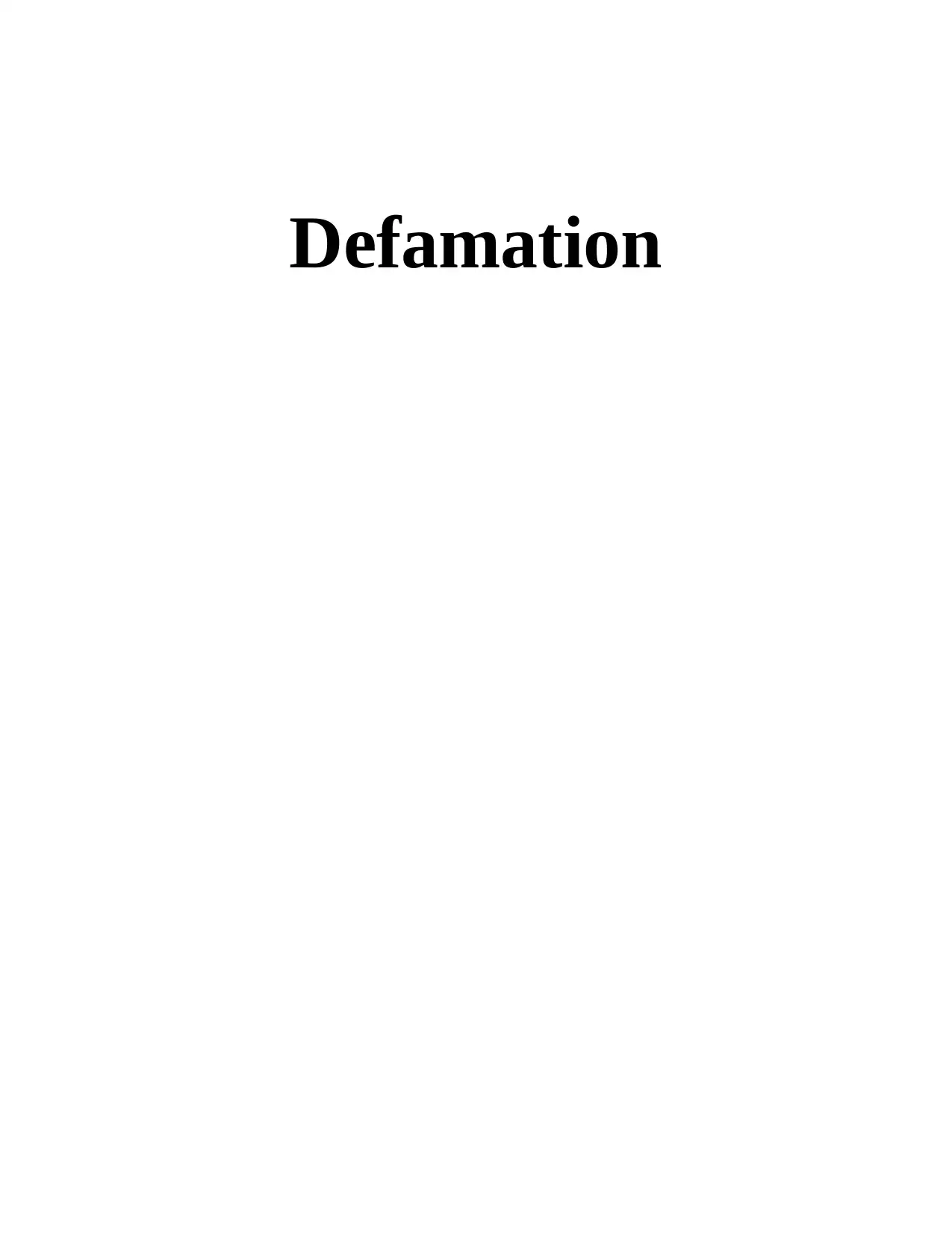
Defamation
Paraphrase This Document
Need a fresh take? Get an instant paraphrase of this document with our AI Paraphraser
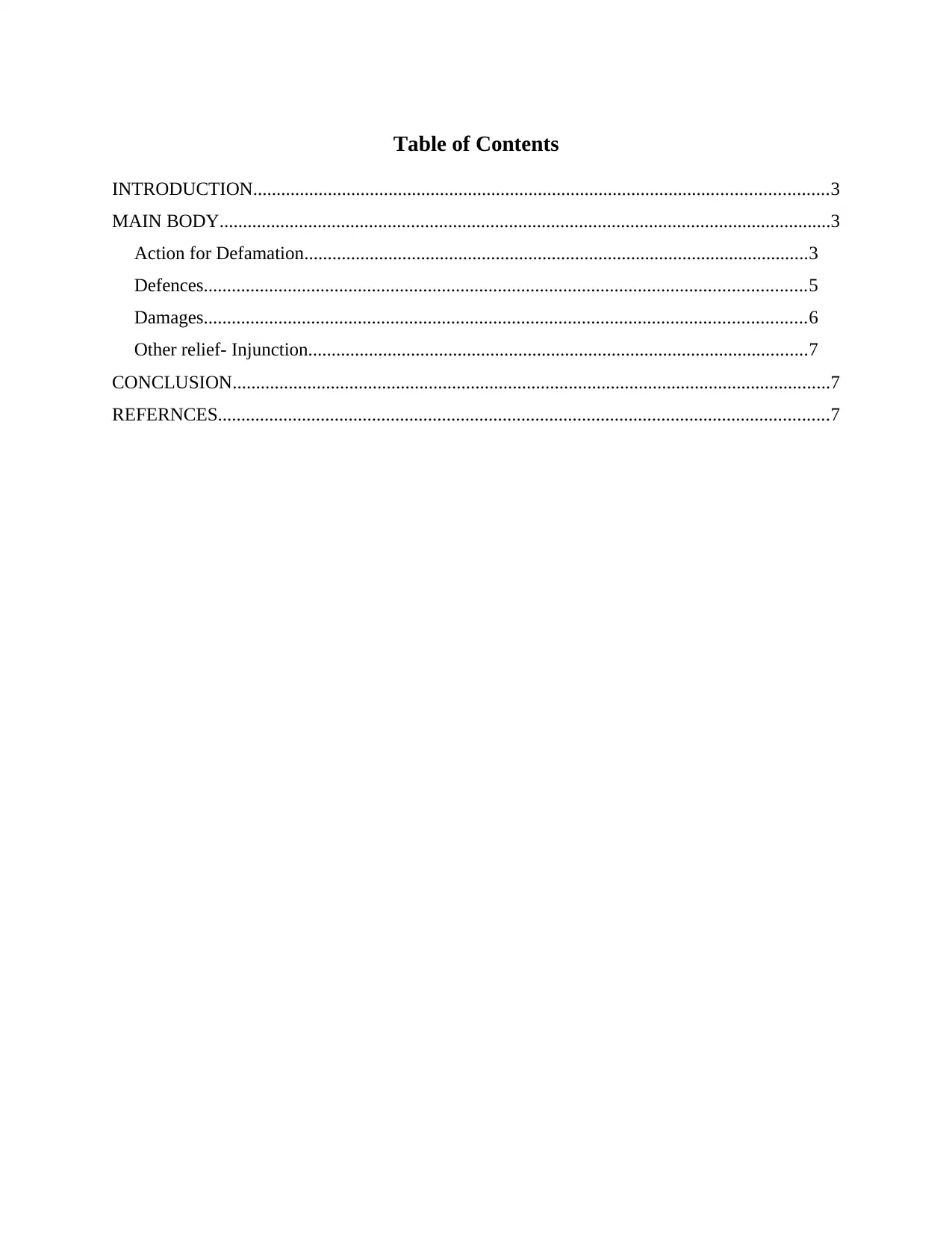
Table of Contents
INTRODUCTION...........................................................................................................................3
MAIN BODY...................................................................................................................................3
Action for Defamation............................................................................................................3
Defences.................................................................................................................................5
Damages.................................................................................................................................6
Other relief- Injunction...........................................................................................................7
CONCLUSION................................................................................................................................7
REFERNCES...................................................................................................................................7
INTRODUCTION...........................................................................................................................3
MAIN BODY...................................................................................................................................3
Action for Defamation............................................................................................................3
Defences.................................................................................................................................5
Damages.................................................................................................................................6
Other relief- Injunction...........................................................................................................7
CONCLUSION................................................................................................................................7
REFERNCES...................................................................................................................................7
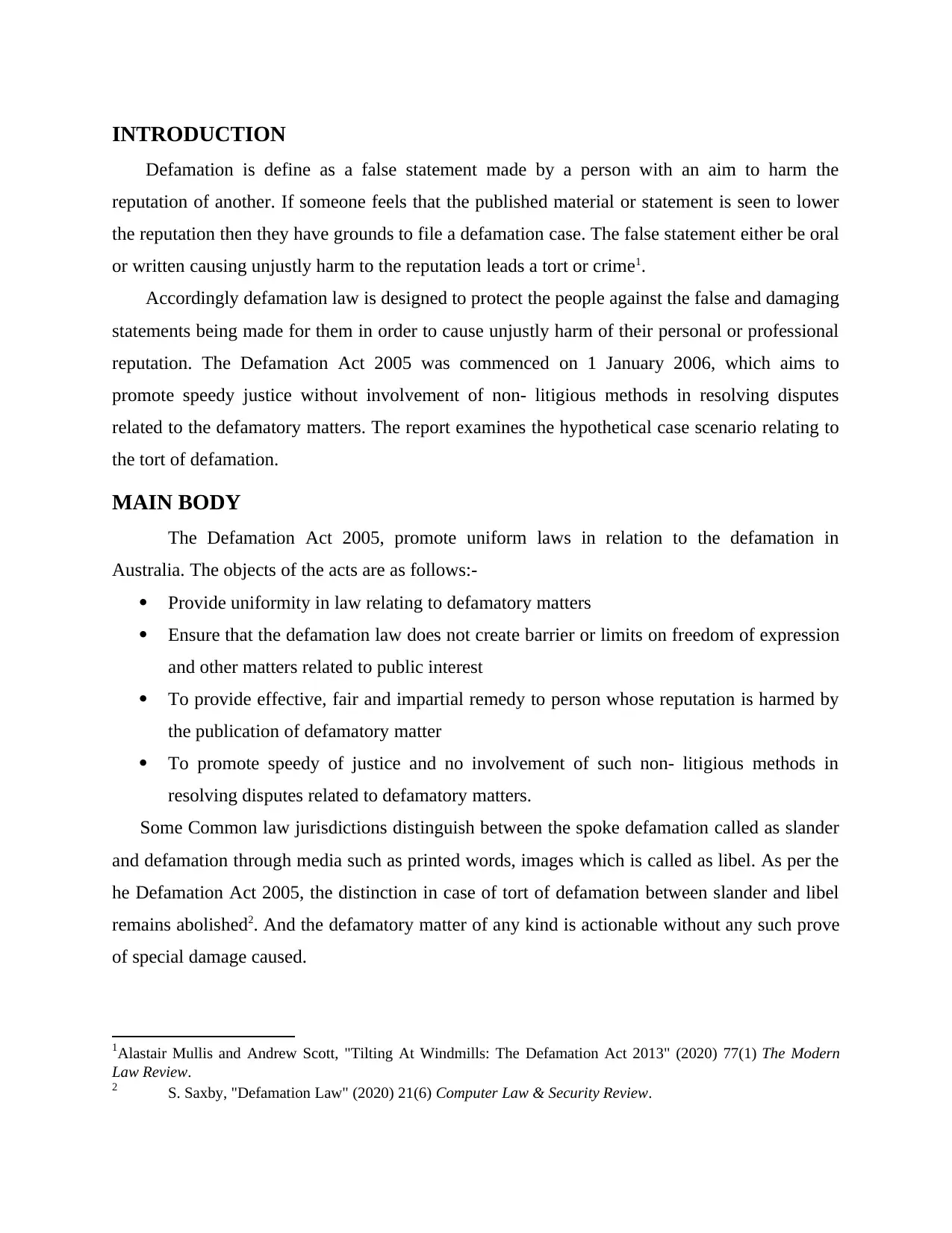
INTRODUCTION
Defamation is define as a false statement made by a person with an aim to harm the
reputation of another. If someone feels that the published material or statement is seen to lower
the reputation then they have grounds to file a defamation case. The false statement either be oral
or written causing unjustly harm to the reputation leads a tort or crime1.
Accordingly defamation law is designed to protect the people against the false and damaging
statements being made for them in order to cause unjustly harm of their personal or professional
reputation. The Defamation Act 2005 was commenced on 1 January 2006, which aims to
promote speedy justice without involvement of non- litigious methods in resolving disputes
related to the defamatory matters. The report examines the hypothetical case scenario relating to
the tort of defamation.
MAIN BODY
The Defamation Act 2005, promote uniform laws in relation to the defamation in
Australia. The objects of the acts are as follows:-
Provide uniformity in law relating to defamatory matters
Ensure that the defamation law does not create barrier or limits on freedom of expression
and other matters related to public interest
To provide effective, fair and impartial remedy to person whose reputation is harmed by
the publication of defamatory matter
To promote speedy of justice and no involvement of such non- litigious methods in
resolving disputes related to defamatory matters.
Some Common law jurisdictions distinguish between the spoke defamation called as slander
and defamation through media such as printed words, images which is called as libel. As per the
he Defamation Act 2005, the distinction in case of tort of defamation between slander and libel
remains abolished2. And the defamatory matter of any kind is actionable without any such prove
of special damage caused.
1Alastair Mullis and Andrew Scott, "Tilting At Windmills: The Defamation Act 2013" (2020) 77(1) The Modern
Law Review.
2 S. Saxby, "Defamation Law" (2020) 21(6) Computer Law & Security Review.
Defamation is define as a false statement made by a person with an aim to harm the
reputation of another. If someone feels that the published material or statement is seen to lower
the reputation then they have grounds to file a defamation case. The false statement either be oral
or written causing unjustly harm to the reputation leads a tort or crime1.
Accordingly defamation law is designed to protect the people against the false and damaging
statements being made for them in order to cause unjustly harm of their personal or professional
reputation. The Defamation Act 2005 was commenced on 1 January 2006, which aims to
promote speedy justice without involvement of non- litigious methods in resolving disputes
related to the defamatory matters. The report examines the hypothetical case scenario relating to
the tort of defamation.
MAIN BODY
The Defamation Act 2005, promote uniform laws in relation to the defamation in
Australia. The objects of the acts are as follows:-
Provide uniformity in law relating to defamatory matters
Ensure that the defamation law does not create barrier or limits on freedom of expression
and other matters related to public interest
To provide effective, fair and impartial remedy to person whose reputation is harmed by
the publication of defamatory matter
To promote speedy of justice and no involvement of such non- litigious methods in
resolving disputes related to defamatory matters.
Some Common law jurisdictions distinguish between the spoke defamation called as slander
and defamation through media such as printed words, images which is called as libel. As per the
he Defamation Act 2005, the distinction in case of tort of defamation between slander and libel
remains abolished2. And the defamatory matter of any kind is actionable without any such prove
of special damage caused.
1Alastair Mullis and Andrew Scott, "Tilting At Windmills: The Defamation Act 2013" (2020) 77(1) The Modern
Law Review.
2 S. Saxby, "Defamation Law" (2020) 21(6) Computer Law & Security Review.
⊘ This is a preview!⊘
Do you want full access?
Subscribe today to unlock all pages.

Trusted by 1+ million students worldwide
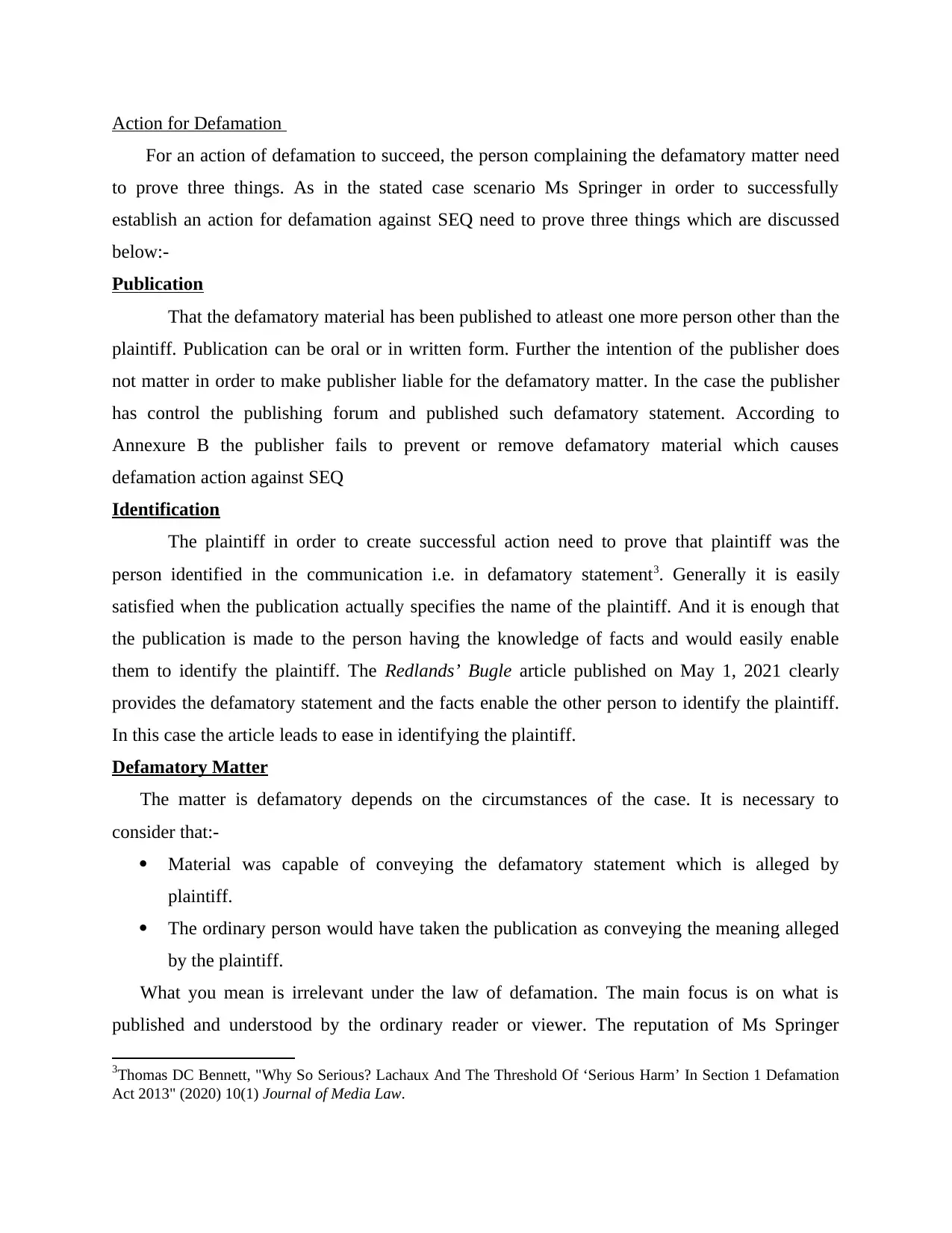
Action for Defamation
For an action of defamation to succeed, the person complaining the defamatory matter need
to prove three things. As in the stated case scenario Ms Springer in order to successfully
establish an action for defamation against SEQ need to prove three things which are discussed
below:-
Publication
That the defamatory material has been published to atleast one more person other than the
plaintiff. Publication can be oral or in written form. Further the intention of the publisher does
not matter in order to make publisher liable for the defamatory matter. In the case the publisher
has control the publishing forum and published such defamatory statement. According to
Annexure B the publisher fails to prevent or remove defamatory material which causes
defamation action against SEQ
Identification
The plaintiff in order to create successful action need to prove that plaintiff was the
person identified in the communication i.e. in defamatory statement3. Generally it is easily
satisfied when the publication actually specifies the name of the plaintiff. And it is enough that
the publication is made to the person having the knowledge of facts and would easily enable
them to identify the plaintiff. The Redlands’ Bugle article published on May 1, 2021 clearly
provides the defamatory statement and the facts enable the other person to identify the plaintiff.
In this case the article leads to ease in identifying the plaintiff.
Defamatory Matter
The matter is defamatory depends on the circumstances of the case. It is necessary to
consider that:-
Material was capable of conveying the defamatory statement which is alleged by
plaintiff.
The ordinary person would have taken the publication as conveying the meaning alleged
by the plaintiff.
What you mean is irrelevant under the law of defamation. The main focus is on what is
published and understood by the ordinary reader or viewer. The reputation of Ms Springer
3Thomas DC Bennett, "Why So Serious? Lachaux And The Threshold Of ‘Serious Harm’ In Section 1 Defamation
Act 2013" (2020) 10(1) Journal of Media Law.
For an action of defamation to succeed, the person complaining the defamatory matter need
to prove three things. As in the stated case scenario Ms Springer in order to successfully
establish an action for defamation against SEQ need to prove three things which are discussed
below:-
Publication
That the defamatory material has been published to atleast one more person other than the
plaintiff. Publication can be oral or in written form. Further the intention of the publisher does
not matter in order to make publisher liable for the defamatory matter. In the case the publisher
has control the publishing forum and published such defamatory statement. According to
Annexure B the publisher fails to prevent or remove defamatory material which causes
defamation action against SEQ
Identification
The plaintiff in order to create successful action need to prove that plaintiff was the
person identified in the communication i.e. in defamatory statement3. Generally it is easily
satisfied when the publication actually specifies the name of the plaintiff. And it is enough that
the publication is made to the person having the knowledge of facts and would easily enable
them to identify the plaintiff. The Redlands’ Bugle article published on May 1, 2021 clearly
provides the defamatory statement and the facts enable the other person to identify the plaintiff.
In this case the article leads to ease in identifying the plaintiff.
Defamatory Matter
The matter is defamatory depends on the circumstances of the case. It is necessary to
consider that:-
Material was capable of conveying the defamatory statement which is alleged by
plaintiff.
The ordinary person would have taken the publication as conveying the meaning alleged
by the plaintiff.
What you mean is irrelevant under the law of defamation. The main focus is on what is
published and understood by the ordinary reader or viewer. The reputation of Ms Springer
3Thomas DC Bennett, "Why So Serious? Lachaux And The Threshold Of ‘Serious Harm’ In Section 1 Defamation
Act 2013" (2020) 10(1) Journal of Media Law.
Paraphrase This Document
Need a fresh take? Get an instant paraphrase of this document with our AI Paraphraser
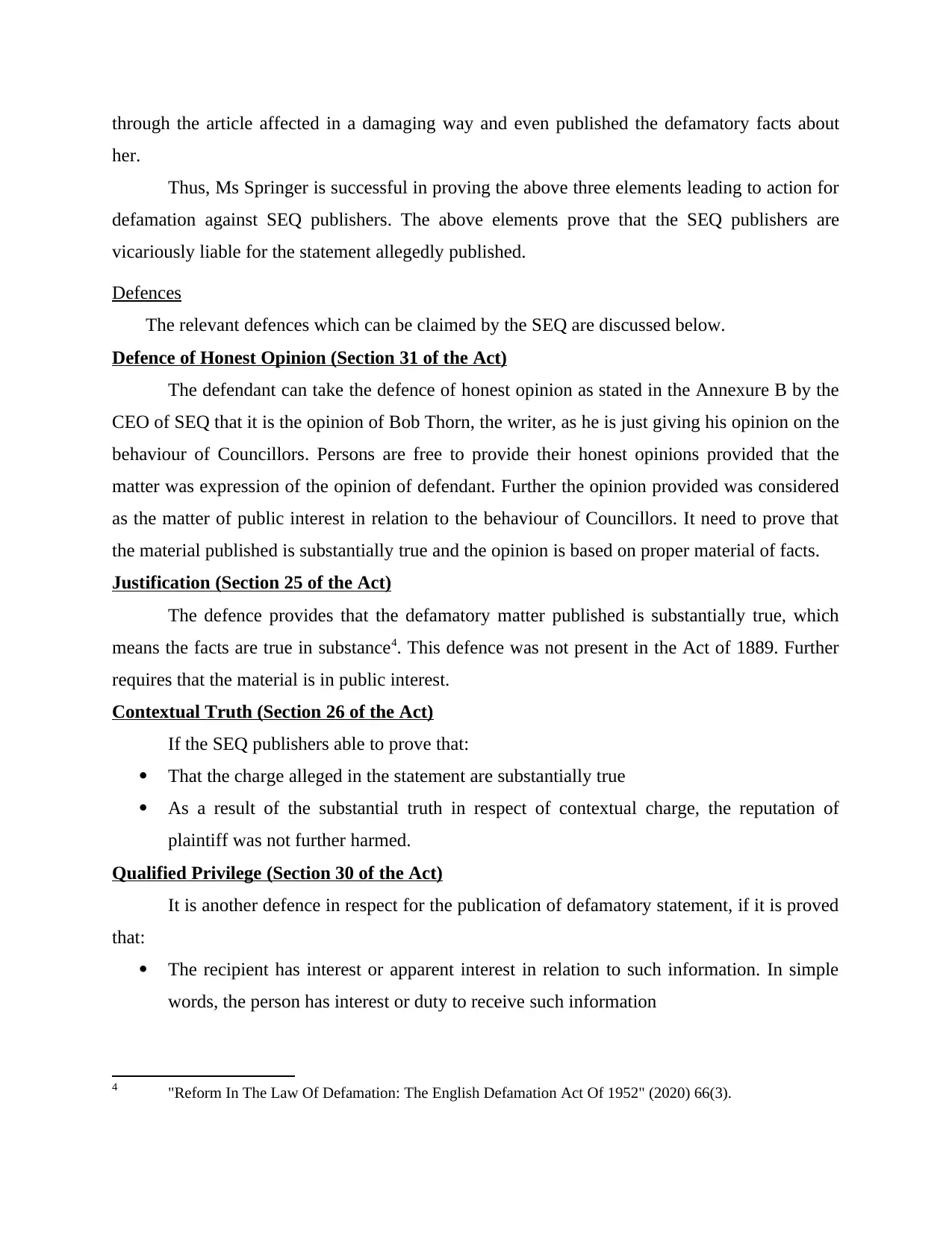
through the article affected in a damaging way and even published the defamatory facts about
her.
Thus, Ms Springer is successful in proving the above three elements leading to action for
defamation against SEQ publishers. The above elements prove that the SEQ publishers are
vicariously liable for the statement allegedly published.
Defences
The relevant defences which can be claimed by the SEQ are discussed below.
Defence of Honest Opinion (Section 31 of the Act)
The defendant can take the defence of honest opinion as stated in the Annexure B by the
CEO of SEQ that it is the opinion of Bob Thorn, the writer, as he is just giving his opinion on the
behaviour of Councillors. Persons are free to provide their honest opinions provided that the
matter was expression of the opinion of defendant. Further the opinion provided was considered
as the matter of public interest in relation to the behaviour of Councillors. It need to prove that
the material published is substantially true and the opinion is based on proper material of facts.
Justification (Section 25 of the Act)
The defence provides that the defamatory matter published is substantially true, which
means the facts are true in substance4. This defence was not present in the Act of 1889. Further
requires that the material is in public interest.
Contextual Truth (Section 26 of the Act)
If the SEQ publishers able to prove that:
That the charge alleged in the statement are substantially true
As a result of the substantial truth in respect of contextual charge, the reputation of
plaintiff was not further harmed.
Qualified Privilege (Section 30 of the Act)
It is another defence in respect for the publication of defamatory statement, if it is proved
that:
The recipient has interest or apparent interest in relation to such information. In simple
words, the person has interest or duty to receive such information
4 "Reform In The Law Of Defamation: The English Defamation Act Of 1952" (2020) 66(3).
her.
Thus, Ms Springer is successful in proving the above three elements leading to action for
defamation against SEQ publishers. The above elements prove that the SEQ publishers are
vicariously liable for the statement allegedly published.
Defences
The relevant defences which can be claimed by the SEQ are discussed below.
Defence of Honest Opinion (Section 31 of the Act)
The defendant can take the defence of honest opinion as stated in the Annexure B by the
CEO of SEQ that it is the opinion of Bob Thorn, the writer, as he is just giving his opinion on the
behaviour of Councillors. Persons are free to provide their honest opinions provided that the
matter was expression of the opinion of defendant. Further the opinion provided was considered
as the matter of public interest in relation to the behaviour of Councillors. It need to prove that
the material published is substantially true and the opinion is based on proper material of facts.
Justification (Section 25 of the Act)
The defence provides that the defamatory matter published is substantially true, which
means the facts are true in substance4. This defence was not present in the Act of 1889. Further
requires that the material is in public interest.
Contextual Truth (Section 26 of the Act)
If the SEQ publishers able to prove that:
That the charge alleged in the statement are substantially true
As a result of the substantial truth in respect of contextual charge, the reputation of
plaintiff was not further harmed.
Qualified Privilege (Section 30 of the Act)
It is another defence in respect for the publication of defamatory statement, if it is proved
that:
The recipient has interest or apparent interest in relation to such information. In simple
words, the person has interest or duty to receive such information
4 "Reform In The Law Of Defamation: The English Defamation Act Of 1952" (2020) 66(3).
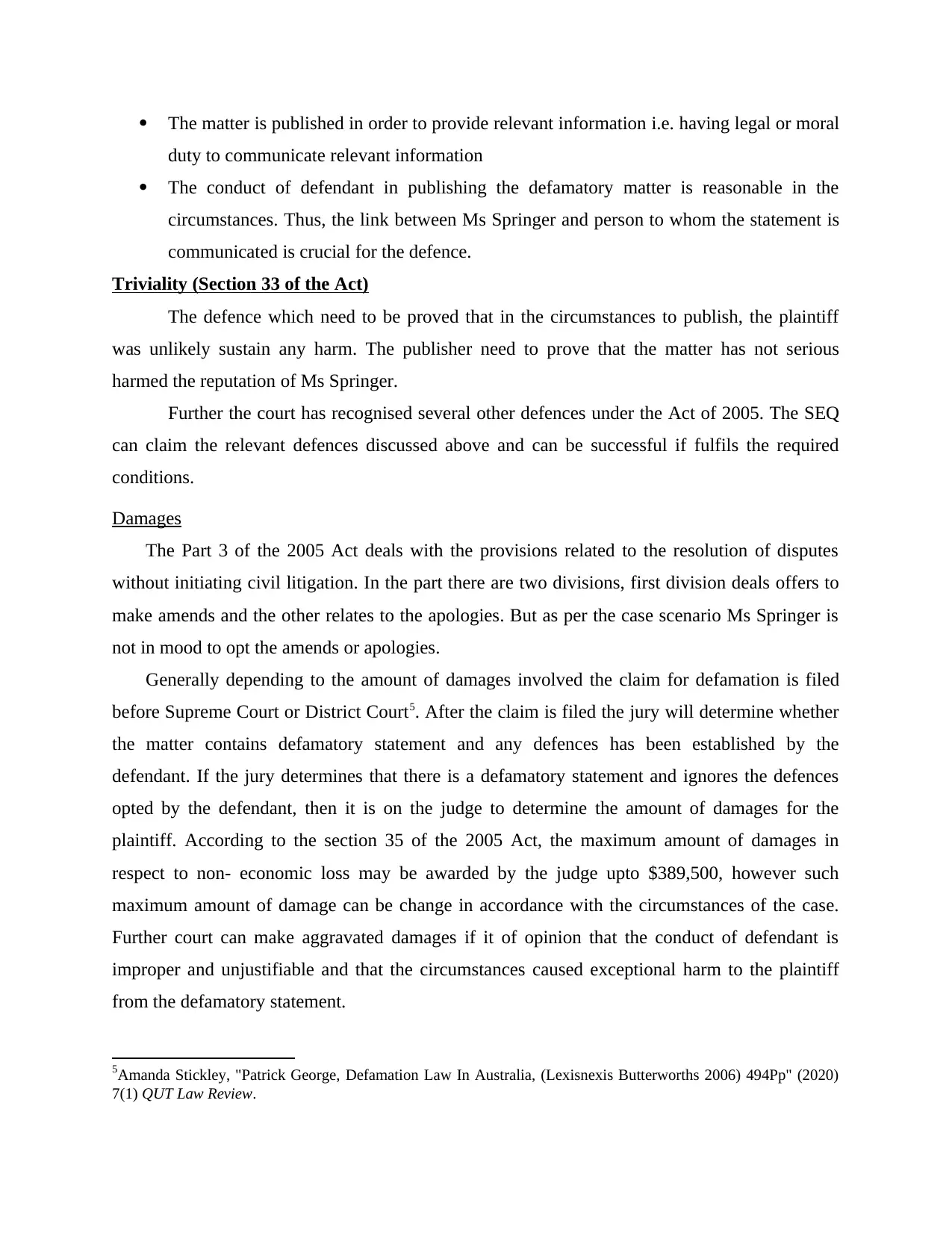
The matter is published in order to provide relevant information i.e. having legal or moral
duty to communicate relevant information
The conduct of defendant in publishing the defamatory matter is reasonable in the
circumstances. Thus, the link between Ms Springer and person to whom the statement is
communicated is crucial for the defence.
Triviality (Section 33 of the Act)
The defence which need to be proved that in the circumstances to publish, the plaintiff
was unlikely sustain any harm. The publisher need to prove that the matter has not serious
harmed the reputation of Ms Springer.
Further the court has recognised several other defences under the Act of 2005. The SEQ
can claim the relevant defences discussed above and can be successful if fulfils the required
conditions.
Damages
The Part 3 of the 2005 Act deals with the provisions related to the resolution of disputes
without initiating civil litigation. In the part there are two divisions, first division deals offers to
make amends and the other relates to the apologies. But as per the case scenario Ms Springer is
not in mood to opt the amends or apologies.
Generally depending to the amount of damages involved the claim for defamation is filed
before Supreme Court or District Court5. After the claim is filed the jury will determine whether
the matter contains defamatory statement and any defences has been established by the
defendant. If the jury determines that there is a defamatory statement and ignores the defences
opted by the defendant, then it is on the judge to determine the amount of damages for the
plaintiff. According to the section 35 of the 2005 Act, the maximum amount of damages in
respect to non- economic loss may be awarded by the judge upto $389,500, however such
maximum amount of damage can be change in accordance with the circumstances of the case.
Further court can make aggravated damages if it of opinion that the conduct of defendant is
improper and unjustifiable and that the circumstances caused exceptional harm to the plaintiff
from the defamatory statement.
5Amanda Stickley, "Patrick George, Defamation Law In Australia, (Lexisnexis Butterworths 2006) 494Pp" (2020)
7(1) QUT Law Review.
duty to communicate relevant information
The conduct of defendant in publishing the defamatory matter is reasonable in the
circumstances. Thus, the link between Ms Springer and person to whom the statement is
communicated is crucial for the defence.
Triviality (Section 33 of the Act)
The defence which need to be proved that in the circumstances to publish, the plaintiff
was unlikely sustain any harm. The publisher need to prove that the matter has not serious
harmed the reputation of Ms Springer.
Further the court has recognised several other defences under the Act of 2005. The SEQ
can claim the relevant defences discussed above and can be successful if fulfils the required
conditions.
Damages
The Part 3 of the 2005 Act deals with the provisions related to the resolution of disputes
without initiating civil litigation. In the part there are two divisions, first division deals offers to
make amends and the other relates to the apologies. But as per the case scenario Ms Springer is
not in mood to opt the amends or apologies.
Generally depending to the amount of damages involved the claim for defamation is filed
before Supreme Court or District Court5. After the claim is filed the jury will determine whether
the matter contains defamatory statement and any defences has been established by the
defendant. If the jury determines that there is a defamatory statement and ignores the defences
opted by the defendant, then it is on the judge to determine the amount of damages for the
plaintiff. According to the section 35 of the 2005 Act, the maximum amount of damages in
respect to non- economic loss may be awarded by the judge upto $389,500, however such
maximum amount of damage can be change in accordance with the circumstances of the case.
Further court can make aggravated damages if it of opinion that the conduct of defendant is
improper and unjustifiable and that the circumstances caused exceptional harm to the plaintiff
from the defamatory statement.
5Amanda Stickley, "Patrick George, Defamation Law In Australia, (Lexisnexis Butterworths 2006) 494Pp" (2020)
7(1) QUT Law Review.
⊘ This is a preview!⊘
Do you want full access?
Subscribe today to unlock all pages.

Trusted by 1+ million students worldwide
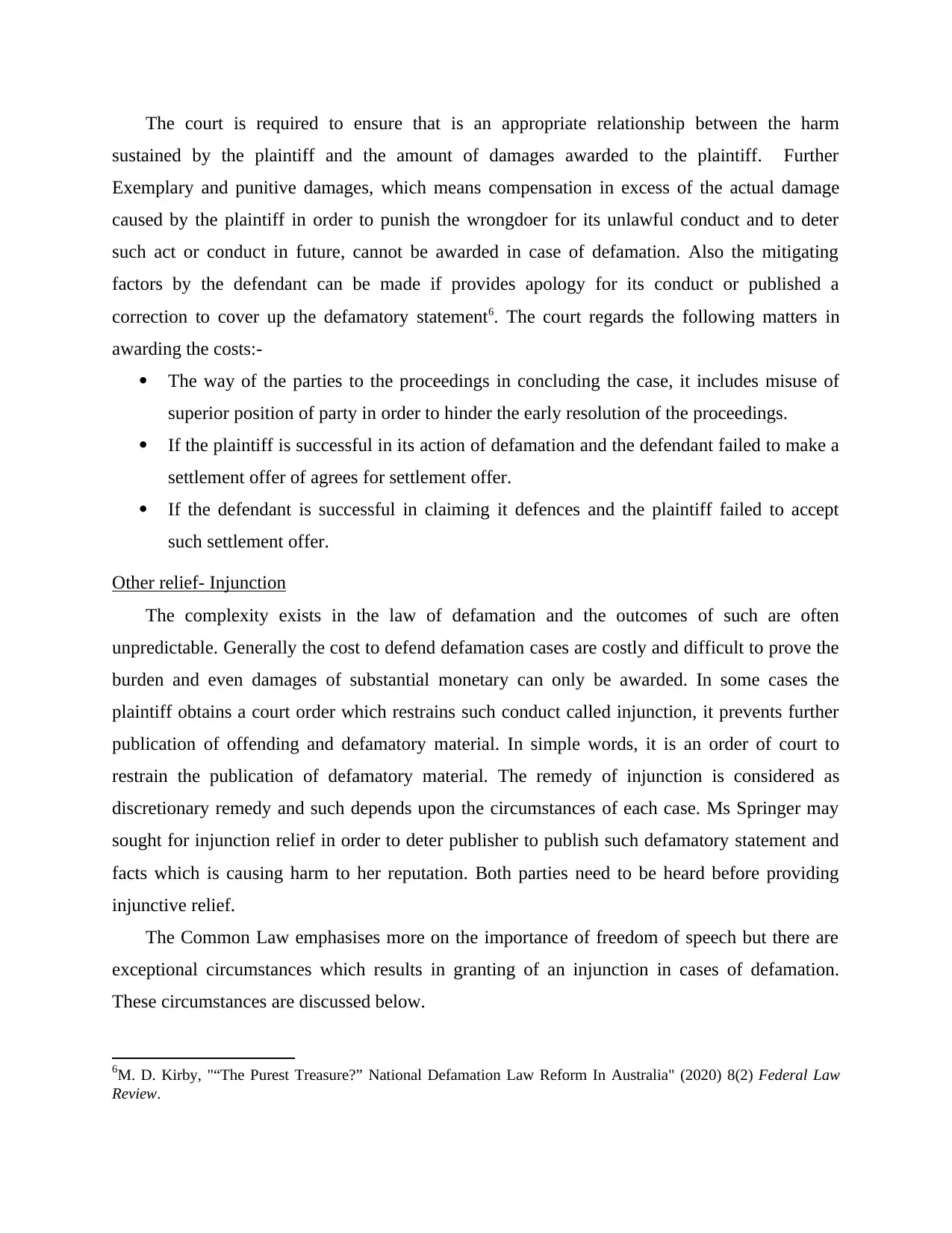
The court is required to ensure that is an appropriate relationship between the harm
sustained by the plaintiff and the amount of damages awarded to the plaintiff. Further
Exemplary and punitive damages, which means compensation in excess of the actual damage
caused by the plaintiff in order to punish the wrongdoer for its unlawful conduct and to deter
such act or conduct in future, cannot be awarded in case of defamation. Also the mitigating
factors by the defendant can be made if provides apology for its conduct or published a
correction to cover up the defamatory statement6. The court regards the following matters in
awarding the costs:-
The way of the parties to the proceedings in concluding the case, it includes misuse of
superior position of party in order to hinder the early resolution of the proceedings.
If the plaintiff is successful in its action of defamation and the defendant failed to make a
settlement offer of agrees for settlement offer.
If the defendant is successful in claiming it defences and the plaintiff failed to accept
such settlement offer.
Other relief- Injunction
The complexity exists in the law of defamation and the outcomes of such are often
unpredictable. Generally the cost to defend defamation cases are costly and difficult to prove the
burden and even damages of substantial monetary can only be awarded. In some cases the
plaintiff obtains a court order which restrains such conduct called injunction, it prevents further
publication of offending and defamatory material. In simple words, it is an order of court to
restrain the publication of defamatory material. The remedy of injunction is considered as
discretionary remedy and such depends upon the circumstances of each case. Ms Springer may
sought for injunction relief in order to deter publisher to publish such defamatory statement and
facts which is causing harm to her reputation. Both parties need to be heard before providing
injunctive relief.
The Common Law emphasises more on the importance of freedom of speech but there are
exceptional circumstances which results in granting of an injunction in cases of defamation.
These circumstances are discussed below.
6M. D. Kirby, "“The Purest Treasure?” National Defamation Law Reform In Australia" (2020) 8(2) Federal Law
Review.
sustained by the plaintiff and the amount of damages awarded to the plaintiff. Further
Exemplary and punitive damages, which means compensation in excess of the actual damage
caused by the plaintiff in order to punish the wrongdoer for its unlawful conduct and to deter
such act or conduct in future, cannot be awarded in case of defamation. Also the mitigating
factors by the defendant can be made if provides apology for its conduct or published a
correction to cover up the defamatory statement6. The court regards the following matters in
awarding the costs:-
The way of the parties to the proceedings in concluding the case, it includes misuse of
superior position of party in order to hinder the early resolution of the proceedings.
If the plaintiff is successful in its action of defamation and the defendant failed to make a
settlement offer of agrees for settlement offer.
If the defendant is successful in claiming it defences and the plaintiff failed to accept
such settlement offer.
Other relief- Injunction
The complexity exists in the law of defamation and the outcomes of such are often
unpredictable. Generally the cost to defend defamation cases are costly and difficult to prove the
burden and even damages of substantial monetary can only be awarded. In some cases the
plaintiff obtains a court order which restrains such conduct called injunction, it prevents further
publication of offending and defamatory material. In simple words, it is an order of court to
restrain the publication of defamatory material. The remedy of injunction is considered as
discretionary remedy and such depends upon the circumstances of each case. Ms Springer may
sought for injunction relief in order to deter publisher to publish such defamatory statement and
facts which is causing harm to her reputation. Both parties need to be heard before providing
injunctive relief.
The Common Law emphasises more on the importance of freedom of speech but there are
exceptional circumstances which results in granting of an injunction in cases of defamation.
These circumstances are discussed below.
6M. D. Kirby, "“The Purest Treasure?” National Defamation Law Reform In Australia" (2020) 8(2) Federal Law
Review.
Paraphrase This Document
Need a fresh take? Get an instant paraphrase of this document with our AI Paraphraser
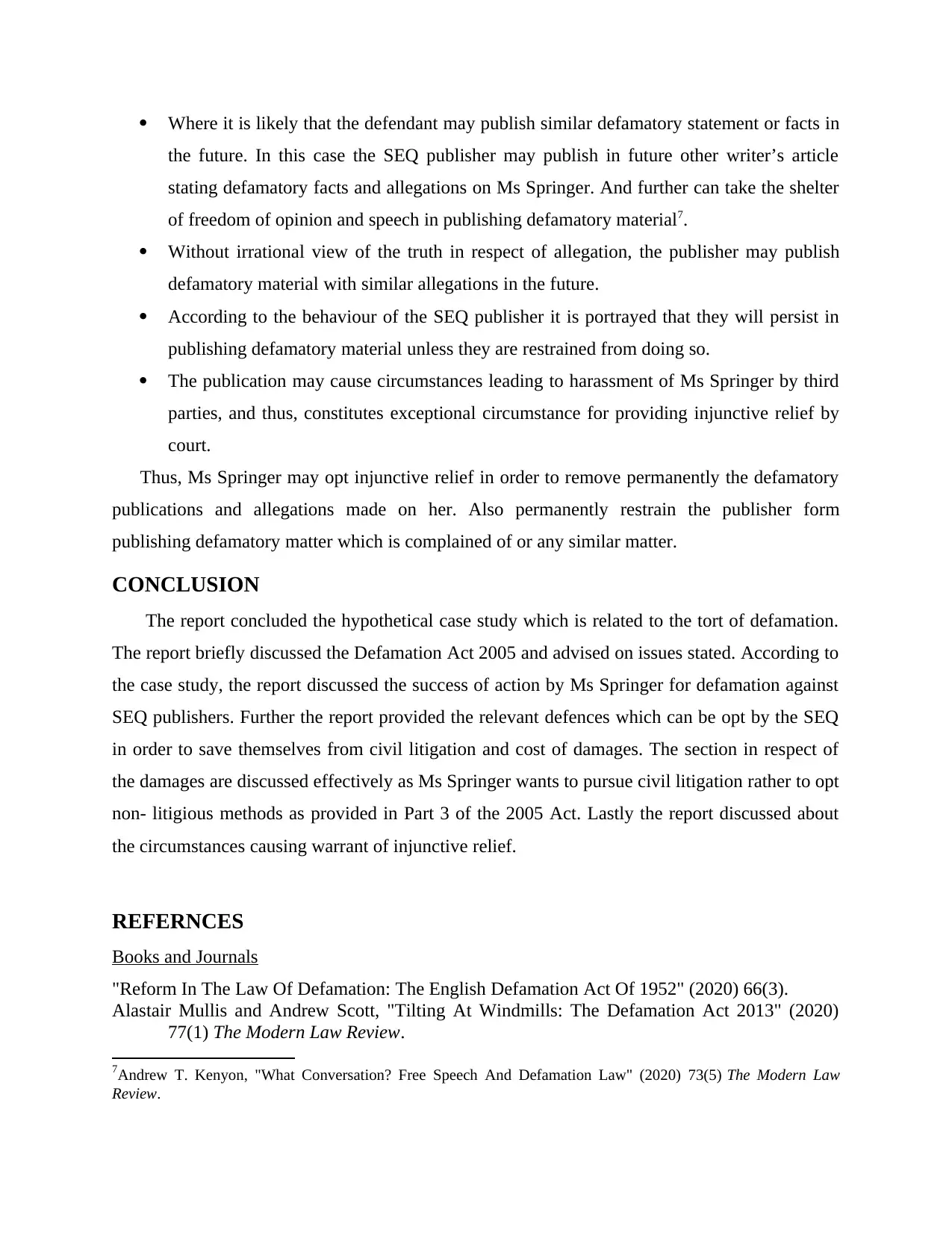
Where it is likely that the defendant may publish similar defamatory statement or facts in
the future. In this case the SEQ publisher may publish in future other writer’s article
stating defamatory facts and allegations on Ms Springer. And further can take the shelter
of freedom of opinion and speech in publishing defamatory material7.
Without irrational view of the truth in respect of allegation, the publisher may publish
defamatory material with similar allegations in the future.
According to the behaviour of the SEQ publisher it is portrayed that they will persist in
publishing defamatory material unless they are restrained from doing so.
The publication may cause circumstances leading to harassment of Ms Springer by third
parties, and thus, constitutes exceptional circumstance for providing injunctive relief by
court.
Thus, Ms Springer may opt injunctive relief in order to remove permanently the defamatory
publications and allegations made on her. Also permanently restrain the publisher form
publishing defamatory matter which is complained of or any similar matter.
CONCLUSION
The report concluded the hypothetical case study which is related to the tort of defamation.
The report briefly discussed the Defamation Act 2005 and advised on issues stated. According to
the case study, the report discussed the success of action by Ms Springer for defamation against
SEQ publishers. Further the report provided the relevant defences which can be opt by the SEQ
in order to save themselves from civil litigation and cost of damages. The section in respect of
the damages are discussed effectively as Ms Springer wants to pursue civil litigation rather to opt
non- litigious methods as provided in Part 3 of the 2005 Act. Lastly the report discussed about
the circumstances causing warrant of injunctive relief.
REFERNCES
Books and Journals
"Reform In The Law Of Defamation: The English Defamation Act Of 1952" (2020) 66(3).
Alastair Mullis and Andrew Scott, "Tilting At Windmills: The Defamation Act 2013" (2020)
77(1) The Modern Law Review.
7Andrew T. Kenyon, "What Conversation? Free Speech And Defamation Law" (2020) 73(5) The Modern Law
Review.
the future. In this case the SEQ publisher may publish in future other writer’s article
stating defamatory facts and allegations on Ms Springer. And further can take the shelter
of freedom of opinion and speech in publishing defamatory material7.
Without irrational view of the truth in respect of allegation, the publisher may publish
defamatory material with similar allegations in the future.
According to the behaviour of the SEQ publisher it is portrayed that they will persist in
publishing defamatory material unless they are restrained from doing so.
The publication may cause circumstances leading to harassment of Ms Springer by third
parties, and thus, constitutes exceptional circumstance for providing injunctive relief by
court.
Thus, Ms Springer may opt injunctive relief in order to remove permanently the defamatory
publications and allegations made on her. Also permanently restrain the publisher form
publishing defamatory matter which is complained of or any similar matter.
CONCLUSION
The report concluded the hypothetical case study which is related to the tort of defamation.
The report briefly discussed the Defamation Act 2005 and advised on issues stated. According to
the case study, the report discussed the success of action by Ms Springer for defamation against
SEQ publishers. Further the report provided the relevant defences which can be opt by the SEQ
in order to save themselves from civil litigation and cost of damages. The section in respect of
the damages are discussed effectively as Ms Springer wants to pursue civil litigation rather to opt
non- litigious methods as provided in Part 3 of the 2005 Act. Lastly the report discussed about
the circumstances causing warrant of injunctive relief.
REFERNCES
Books and Journals
"Reform In The Law Of Defamation: The English Defamation Act Of 1952" (2020) 66(3).
Alastair Mullis and Andrew Scott, "Tilting At Windmills: The Defamation Act 2013" (2020)
77(1) The Modern Law Review.
7Andrew T. Kenyon, "What Conversation? Free Speech And Defamation Law" (2020) 73(5) The Modern Law
Review.
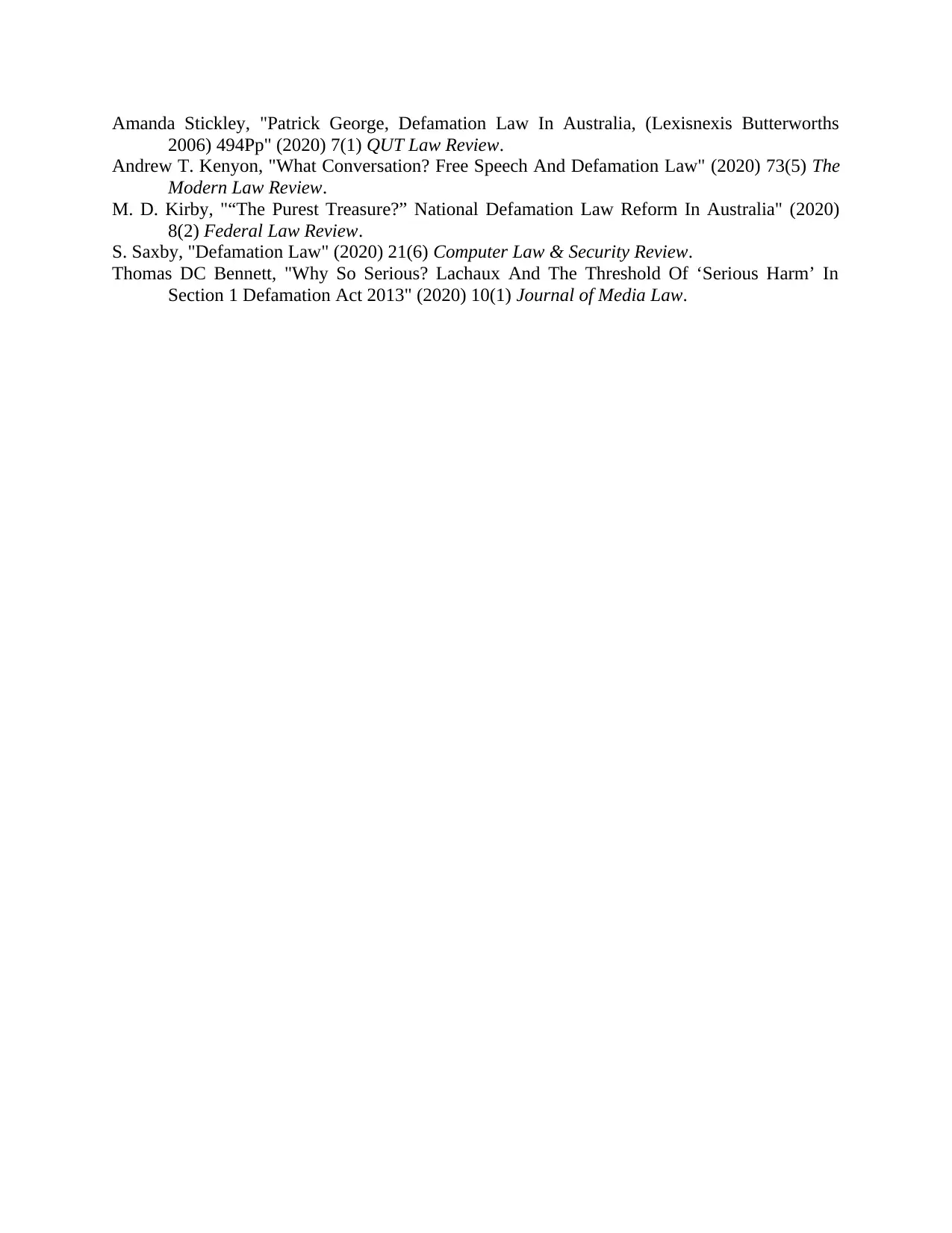
Amanda Stickley, "Patrick George, Defamation Law In Australia, (Lexisnexis Butterworths
2006) 494Pp" (2020) 7(1) QUT Law Review.
Andrew T. Kenyon, "What Conversation? Free Speech And Defamation Law" (2020) 73(5) The
Modern Law Review.
M. D. Kirby, "“The Purest Treasure?” National Defamation Law Reform In Australia" (2020)
8(2) Federal Law Review.
S. Saxby, "Defamation Law" (2020) 21(6) Computer Law & Security Review.
Thomas DC Bennett, "Why So Serious? Lachaux And The Threshold Of ‘Serious Harm’ In
Section 1 Defamation Act 2013" (2020) 10(1) Journal of Media Law.
2006) 494Pp" (2020) 7(1) QUT Law Review.
Andrew T. Kenyon, "What Conversation? Free Speech And Defamation Law" (2020) 73(5) The
Modern Law Review.
M. D. Kirby, "“The Purest Treasure?” National Defamation Law Reform In Australia" (2020)
8(2) Federal Law Review.
S. Saxby, "Defamation Law" (2020) 21(6) Computer Law & Security Review.
Thomas DC Bennett, "Why So Serious? Lachaux And The Threshold Of ‘Serious Harm’ In
Section 1 Defamation Act 2013" (2020) 10(1) Journal of Media Law.
⊘ This is a preview!⊘
Do you want full access?
Subscribe today to unlock all pages.

Trusted by 1+ million students worldwide
1 out of 9
Related Documents
Your All-in-One AI-Powered Toolkit for Academic Success.
+13062052269
info@desklib.com
Available 24*7 on WhatsApp / Email
![[object Object]](/_next/static/media/star-bottom.7253800d.svg)
Unlock your academic potential
Copyright © 2020–2025 A2Z Services. All Rights Reserved. Developed and managed by ZUCOL.





